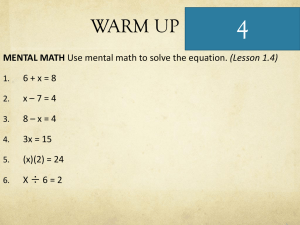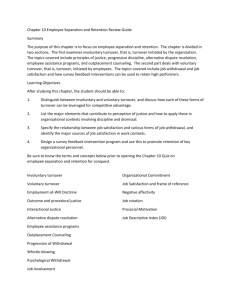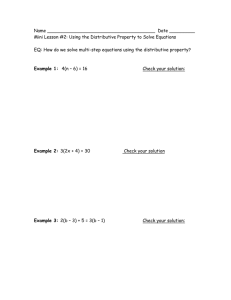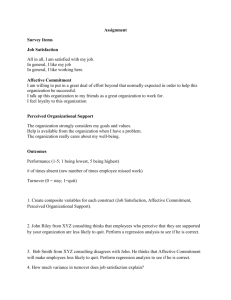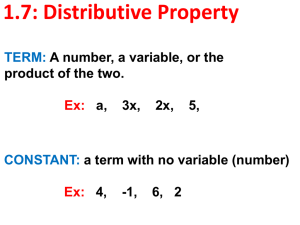Impact of Organizational Justice on Employees Outcomes Abasyn
advertisement
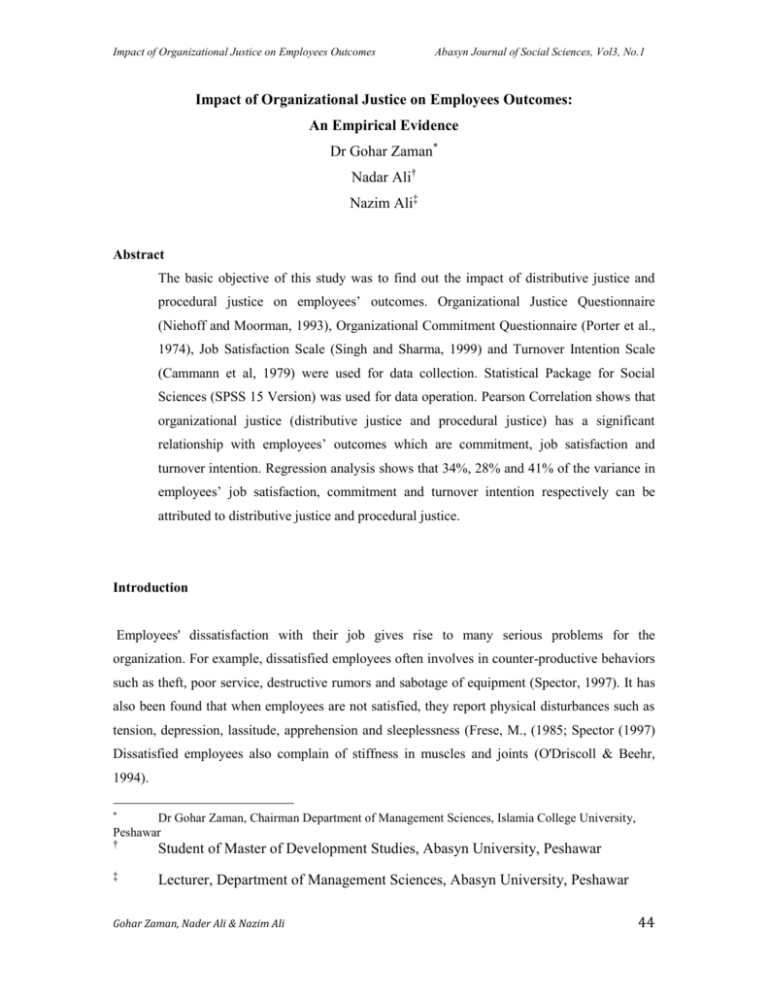
Impact of Organizational Justice on Employees Outcomes Abasyn Journal of Social Sciences, Vol3, No.1 Impact of Organizational Justice on Employees Outcomes: An Empirical Evidence Dr Gohar Zaman* Nadar Ali† Nazim Ali‡ Abstract The basic objective of this study was to find out the impact of distributive justice and procedural justice on employees’ outcomes. Organizational Justice Questionnaire (Niehoff and Moorman, 1993), Organizational Commitment Questionnaire (Porter et al., 1974), Job Satisfaction Scale (Singh and Sharma, 1999) and Turnover Intention Scale (Cammann et al, 1979) were used for data collection. Statistical Package for Social Sciences (SPSS 15 Version) was used for data operation. Pearson Correlation shows that organizational justice (distributive justice and procedural justice) has a significant relationship with employees’ outcomes which are commitment, job satisfaction and turnover intention. Regression analysis shows that 34%, 28% and 41% of the variance in employees’ job satisfaction, commitment and turnover intention respectively can be attributed to distributive justice and procedural justice. Introduction Employees' dissatisfaction with their job gives rise to many serious problems for the organization. For example, dissatisfied employees often involves in counter-productive behaviors such as theft, poor service, destructive rumors and sabotage of equipment (Spector, 1997). It has also been found that when employees are not satisfied, they report physical disturbances such as tension, depression, lassitude, apprehension and sleeplessness (Frese, M., (1985; Spector (1997) Dissatisfied employees also complain of stiffness in muscles and joints (O'Driscoll & Beehr, 1994). * Dr Gohar Zaman, Chairman Department of Management Sciences, Islamia College University, Peshawar † Student of Master of Development Studies, Abasyn University, Peshawar ‡ Lecturer, Department of Management Sciences, Abasyn University, Peshawar Gohar Zaman, Nader Ali & Nazim Ali 44 Impact of Organizational Justice on Employees Outcomes Abasyn Journal of Social Sciences, Vol3, No.1 High turnover is always very destructive for the organizational. Organizations spend a lot of money on selection, recruitment, induction and training of new employees (Staw, 1980). Cost of learning, reduced morale, pressure on the existing employees and the loss of social capital are also associated with high turnover rate Des & Shaw (2001). The cost of each quit is $1400 to $4000 (Hogan, 1992). Each employee turnover costs the organization $3000 to $10000 in the form of lost productivity, lost sales and management’s time (Catherine, 2002). No study has been conducted to assess the impact of organizational justice on employees’ outcomes which are job satisfaction, commitment and turnover intention of teachers of private sector schools’ teachers of KPK, Pakistan. Therefore this study is conducted to investigate the impact of organizational justice on employees’ outcomes such as organizational commitment, job satisfaction and turnover intention. Literature Review Organizational justice refers to the overall fairness of the organization reward system and the perceived fairness of the actions of individuals responsible for implementing the rewards allocation system (Cropanzano and Greenberg, 1997). According to Niehoff and Moorman (1993) Distributive justice is the degree to which rewards are allocated in an equitable manner. Procedural justice is the degree to which those affected by allocation decisions perceive them to have been made according to fair methods and guidelines (Folger & Konovsky, 1989, and Greenberg, 1990). Locke and Lathan (1976) define job satisfaction as pleasurable or positive emotional state resulting from the appraisal of ones job or job experience. Distributive Justice and Procedural Justice and Job Satisfaction Many studies conducted have found that both distributive justice and procedural justice are strong predictors of job satisfaction. For instance, McFarlin and Sweeney (1992) in their article titled “Distributive and procedural justice as predictors of satisfaction with personal and organizational outcomes” found that distributive justice and procedural justice were the powerful predictor of job satisfaction. Masterson et al (2000) also found that distributive justice, procedural justice and interactional justice were positively correlated with job satisfaction. In this study it is hypothesized that H1: There is a statistically significant relationship between Distributive Justice and Job Satisfaction Gohar Zaman, Nader Ali & Nazim Ali 45 Impact of Organizational Justice on Employees Outcomes Abasyn Journal of Social Sciences, Vol3, No.1 H2: There is a statistically significant relationship between Procedural Justice and Job Satisfaction Organizational Justice (Distributive Justice and Procedural Justice) and Organizational Commitment Many studies have found that organizational justice is a strong predictor of organizational commitment. For example, Bakhshi et al (2009) in their article titled “Organizational Justice Perceptions as Predictor of Job Satisfaction and Organization Commitment” found that both distributive justice and procedural justice were positively associated with organizational commitment. In this study it is hypothesized that H3: There is a statistically significant positive relationship between Distributive Justice and Organizational Commitment H4: There is a statistically significant positive relationship between Procedural Justice and Organizational Commitment Organizational Justice and Turnover Intentions A plethora of research is available on the relationship between organizational justice and turnover intention. For example, Fatt et al (2010) in their famous article named "The Impact of Organizational Justice on Employee’s Job Satisfaction: The Malaysian Companies Perspectives" found that both distributive justice and procedural justice were correlated with turnover intention. In this study it is hypothesized that H5: There is a statistically significant positive relationship between Distributive Justice and Turnover Intention H6: There is a statistically significant positive relationship between Procedural Justice and Turnover Intention Research Methodology Data collection: Data was collected from three hundreds and sixty six (366) private sector schools’ teachers of KPK, Pakistan. Five hundreds (500) questionnaires were administered. Out of which three hundreds and seventy four (374) questionnaires were returned which shows 74.8% return rate. Eight questionnaires were disposed off because they contained incomplete information. Organizational Justice: Distributive justice and procedural justice were measured by using the 20-item scale developed by Niehoff and Moorman (1993). Distributive justice Gohar Zaman, Nader Ali & Nazim Ali 46 Impact of Organizational Justice on Employees Outcomes Abasyn Journal of Social Sciences, Vol3, No.1 contained five items and procedural justice 15 items. Responses were noted on five point likert scale, from 1 (strongly disagree) to 5 (strongly agree). Scale showed good reliability, .87 and .78 for distributive justice and procedural justice respectively. Turnover Intention: Three (3) items turnover intention scale adapted from Michigan Organizational Assessment Questionnaire (Cammann et al, 1979) was used to measure turnover intention. These three items were "I will likely actively look for a new job in the next year"; "I often think about quitting" and "I probably look for a new job in the next year". Responses were recorded on 5 point likert scale from 1 (Strongly Disagree) to 5 (Strongly Agree). Organizational Commitment:Fourteen (14) items from the questionnaire developed by Porter et al. (1974) were used to measure organizational commitment. Examples include "I find that my values and the organization’s values are very similar" and "I am proud to tell others that I am part of this organization". Responses were recorded on 5 point likert scale from 1 (Strongly Disagree) to 5 (Strongly Agree). The scale showed good = .85). Job Satisfaction: Job satisfaction scale that contained thirty items was adapted from Singh and Sharma (1999). The average of all the items represents the overall job satisfaction level. Example includes “With regard to post retirement benefits, like pension, gratuity, etc., I rate my job as ………..” Responses were recorded on 5 point likert scale from 1 (Strongly Disagree) to 5 = .85). Statistical tools: Statistical Package for Social Sciences (SPSS 15 Version) was used to calculate Mean, Standard Deviation and Pearson Correlation. Findings Table 1: Demographics Age 15-20 21-25 26-30 31-35 36-40 Above 40 Total Gohar Zaman, Nader Ali & Nazim Ali Frequency 36 46 84 97 35 38 Percentage (approx) 13 23 26 10 10 10 366 100 47 Impact of Organizational Justice on Employees Outcomes Age Distribution 120 97 100 Frequency Abasyn Journal of Social Sciences, Vol3, No.1 84 80 60 40 65 36 46 38 Age 20 0 15-20 21-25 26-30 31-35 36-40 Above Years 40 Marital status Married 242 66 Single 124 34 Total 341 100 Marital Status 300 250 200 150 100 50 0 242 124 Married Qualification Marital Status Single Master 303 83 Graduate 63 17 366 100 Total Gohar Zaman, Nader Ali & Nazim Ali 48 Impact of Organizational Justice on Employees Outcomes Abasyn Journal of Social Sciences, Vol3, No.1 Frequency Qualification 350 300 250 200 150 100 50 0 303 Qualification 63 Master Graduate Table 2: Relationship between Distributive Justice and Procedural Justice and Job Satisfaction DJ PJ JS DJ Pearson Correlation 1 .379(**) .471(**) Sig. (2-tailed) .000 .000 N 366 366 366 PJ Pearson Correlation .379(**) 1 .501(**) Sig. (2-tailed) .000 .000 N 366 366 366 JS Pearson Correlation .471(**) .501(**) 1 Sig. (2-tailed) .000 .000 N 366 366 366 ** Correlation is significant at the 0.01 level (2-tailed). Table 2 shows that there is statistically a significant positive relationship between Distributive Justice and Job Satisfaction (r = 0.471, p < 0.001) and Procedural Justice and Job Satisfaction (r = 0.501, p < 0.001). Therefore H1 and H2 are accepted in this study. Table 3: Relationship between Distributive Justice and Procedural Justice and Organizational Commitment Pearson Correlation DJ PJ COM 1 .379(**) .464(**) .000 .000 Sig. (2-tailed) N 366 366 366 Pearson Correlation .379(**) 1 .411(**) Sig. (2-tailed) .000 N 366 366 366 Pearson Correlation .464(**) .411(**) 1 Sig. (2-tailed) .000 .000 N 366 366 .000 366 ** Correlation is significant at the 0.01 level (2-tailed). Gohar Zaman, Nader Ali & Nazim Ali 49 Impact of Organizational Justice on Employees Outcomes Abasyn Journal of Social Sciences, Vol3, No.1 Table 3 shows that there is statistically a significant positive relationship between Distributive Justice and Employees’ Commitment (r = 0.464, p < 0.001) and Procedural Justice and Employees’ Commitment (r = 0.411, p < 0.001). Therefore H3 and H4 are accepted in this study. Table 4: Relationship between Distributive Justice and Procedural Justice and Organizational Turnover Intention DJ 1 Pearson Correlation Sig. (2-tailed) N Pearson Correlation Sig. (2-tailed) N Pearson Correlation Sig. (2-tailed) N PJ .379(**) .000 366 1 366 .379(**) .000 366 -.618(**) .000 366 ** Correlation is significant at the 0.01 level (2-tailed). TI -.618(**) .000 366 -.390(**) .000 366 1 366 -.390(**) .000 366 366 Table 4 shows that there is statistically a significant negative relationship between Distributive Justice and Turnover Intention (r = -0.618, p < 0.001) and Procedural Justice and Turnover Intention (r = -0.390, p < 0.001). Therefore H5 and H6 are accepted in this study. Model Summary Model R 1 .586(a) R Square .343 Adjusted Square .340 R Std. Error of the Estimate 1.10478 F 94.885 Sig. .000(a) a Predictors: (Constant), DJ, PJ Table shows the R Square value .34 that indicates that 34% of the variance in job satisfaction can be accounted for by distributive justice and procedural justice. Coefficients (a) Model 1 (Consta nt) PJ DJ Un-standardized Coefficients Standardized Coefficients t Sig. B Std. Error Betas B Std. Error 1.118 .154 7.279 .000 .348 .043 .376 8.181 .000 .290 .040 .329 7.160 .000 a Dependent Variable: JS The value of Beta in table indicates that procedural justice has 34% impact on job satisfaction of employees and distributive justice has 29% impact on employees’ job satisfaction. Gohar Zaman, Nader Ali & Nazim Ali 50 Impact of Organizational Justice on Employees Outcomes Abasyn Journal of Social Sciences, Vol3, No.1 Model Summary Model 1 R R Square .529(a) .280 a Predictors: (Constant), DJ, PJ Adjusted R Std. Error Square Estimate .276 1.10420 of the F 70.634 Sig. .000(a) Table shows the R Square value .28 that indicates that 28% of the variance in job satisfaction can be accounted for by distributive justice and procedural justice. ANOVA(b) Coefficients(a) Unstandardized Coefficients Model B (Constant) 1.475 PJ .243 DJ .303 a Dependent Variable: COM Standardized Coefficients Std. Error .154 .043 .040 Beta .274 .361 t Sig. B 9.608 5.702 7.493 Std. Error .000 .000 .000 The value of Beta in table indicates that procedural justice has 24% impact on employees’ commitment and distributive justice has 30% impact on employees’ commitment. Model Summary Model 1 R R Square .640(a) .410 a Predictors: (Constant), DJ, PJ Adjusted R Std. Error of Square the Estimate F .407 .98219 126.164 Sig. .000(a) Table shows the R Square value .41 that indicates that 41% of the variance in turnover intention can be accounted for by distributive justice and procedural justice. Coefficients(a) Model (Constant) PJ DJ Unstandardized Coefficients Standardized Coefficients B 3.991 -.158 -.453 Beta Std. Error .137 .038 .036 -.182 -.549 t Sig. B 29.221 -4.186 -12.597 Std. Error .000 .000 .000 a Dependent Variable: TI Gohar Zaman, Nader Ali & Nazim Ali 51 Impact of Organizational Justice on Employees Outcomes Abasyn Journal of Social Sciences, Vol3, No.1 The value of Beta in table indicates that procedural justice has -15% impacts on employees’ turnover intention and distributive justice has -45% impact on employees’ turnover intention. Conclusion and Recommendation This study was conducted to investigate the relationship between organizational justice and employees’ outcomes which are job satisfaction, employees’ commitment and turnover intention amongst the teaching staff of private sector schools of KPK, Pakistan. The result of Pearson Correlation found a significant positive relationship between distributive justice and job satisfaction, procedural justice and job satisfaction, distributive justice and employees’ commitment, procedural justice and organizational commitment and a significant negative correlation between distributive justice and turnover intention and procedural justice and turnover intention. The management is strongly recommended to improve organizational justice policies so as to increase job satisfaction, organizational commitment and to decrease turnover intention. References Bakhshi A, Kumar K and Rani E (2009). Organizational Justice Perceptions as Predictor of Job Satisfaction and Organization Commitment. International Journal of Business and Management, 4 (9), 145-154. Cammann, C., Fichman, M., Jenkins, D. and Klesh, J. 1979. The Michigan Organizational Assessment Questionnaire. Unpublished Maniscript, University of Michigan, Ann Arbor, Michigan. Catherine M Gustafson (2002). Staff turnover: Retention. International journal contemporary Hospital management, 14 (3), 106-110. Cropanzano, R., & Greenberg, J. (1997). Progress in organizational justice: Tunnelling through maze. In C. L. Cooper., & I. T. Robertson (Eds.), International Review of Industrial and Organizational Psychology, Vol. 12, pp.317-372. Chichester: John Wiley & Sons. Fatt C.K, Sek Khin E.W and Heng TN (2010). The Impact of Organizational Justice on Employee’s Job Satisfaction: The Malaysian Companies Perspectives. American Journal of Economics and Business Administration 2 (1): 56-63 Frese, M., (1985). Stress at work and psychosomatic complaints: a causal interpretation. Journal of Applied Psychology, 70, 314-28. Folger, R., & Konovsky, M. A. (1989). Effects of procedural and distributive justice on reactions to pay raise decisions. Academy of Management Journal, 32, pp.115-130. Greenberg, J. (1990). Employee theft as a reaction to underpayment inequity: The hidden costs of pay cuts. Journal of Applied Psychology, 75, pp.561-5 Gohar Zaman, Nader Ali & Nazim Ali 52 Impact of Organizational Justice on Employees Outcomes Abasyn Journal of Social Sciences, Vol3, No.1 Hogan JJ (1992). Turnover and what to do about it, The Cornell HRA Quarterly. 33 (1):40-45. Masterson, S. S., Lewis, K., Goldman, B. M., & Taylor, M. S. (2000). Integrating justice and social exchange: The differing effects of fair procedures and treatment on work relationships. Academy of Management Journal, 43, 738-748. McFarlin, D. B., & Sweeney, P. D. (1992). Distributive and procedural justice as predictors of satisfaction with personal and organizational outcomes. Academy of Management Journal, 35(3), 626-637. Niehoff, B. P. & Moorman, R. H. 1993, “Justice as a mediator of the relationship between methods of monitoring and organizational citizenship behavior”, Academy of Management Journal, vol. 36, pp. 527-556. O'Driscoll, M. P. & Beehr, T. A., (1994). Supervisor behaviors, role stressors and uncertainty as predictors of personal outcomes for subordinates. Journal of Organisational Behavior, 15, 141155. Porter, L.H., Steers, R.M. and Boulian P.V. (1974). Organizational commitment, Job Satisfaction and Turnover Among Psychiatric Technicians. Journal of Applied Psychology, 59(5), 603-609 Singh, A. & Sharma, T.R. (1999). Manual for Job Satisfaction Scale. National Psychological Corporation: Agra Spector, P. E., (1997). Job satisfaction: Application, assessment, causes, and London: Sage Publications. Gohar Zaman, Nader Ali & Nazim Ali consequences. 53



